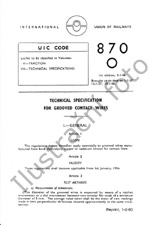Potřebujeme váš souhlas k využití jednotlivých dat, aby se vám mimo jiné mohly ukazovat informace týkající se vašich zájmů. Souhlas udělíte kliknutím na tlačítko „OK“.

UIC 774-3-2ed.
Track - bridge Interaction. Recommendations for calculations
Automaticky přeložený název:
Track - most interakce. Doporučení pro výpočty
NORMA vydána dne 1.10.2001
Informace o normě:
Označení normy: UIC 774-3-2ed.
Datum vydání normy: 1.10.2001
Kód zboží: NS-550417
Počet stran: 76
Přibližná hmotnost: 228 g (0.50 liber)
Země: Mezinárodní technická norma
Kategorie: Technické normy UIC
Anotace textu normy UIC 774-3-2ed. :
Summary:
ry
Interaction between track and bridge, i.e. the consequences of the behaviour of one on the behaviour of the other, occurs because they are interlinked, regardless of whether
the track is directly fastened or has a ballast bed.
This interaction takes the form of forces in the rails and in the deck and its bearings, as well as displacement of the various elements of the bridge and track.
If the interaction is under control, then the bridge will continue to fulfil its function, i.e. supporting the track without the track being subject to anomalies.
There are two types of anomaly: rail fractures, or disruption of the link between track and bridge such that track stability is no longer guaranteed (one notable example of instability is when the ballast loosens following considerable displacement of the bridge deck such that sufficient resistance to lateral buckling at the ends of the bridge is no longer guaranteed).
Therefore interaction - strictly speaking - must be taken into account as a serviceability limit state (SLS) as regards the bridge, as well as being an ultimate limit state (ULS) as regards the rail. Forces and displacements must therefore be calculated using the partial safety factors for the loads concerned. The relevant factors are applied to the forces according to the checks required at ultimate limit state as regards the strength of the bearings and the substructure.
This leaflet, which is a result of the work of ERRI Specialists Committee D 213, gives methods for calculating the forces and displacements that are linked to interaction phenomena.
The acceptable limit states for the track depend on its design and state of maintenance. The permissible limit values given in the leaflet, whether for displacements
or additional stress in the rail due to interaction phenomena, are the values that are widely permitted for standard track components in a good state of maintenance. If a railway for its own reasons operates
outside the foreseen scope of application, that railway will still be able to use the calculation methods in this leaflet by replacing the criteria given here with new criteria based on its own experience
and observations (this mainly concerns 72 N/mm2 for permissible additional compressive stress in the rail and 5 mm displacement of the deck under braking forces).
Similarly, the track strength taken into account and the temperature increase envisaged are drawn from the knowledge of the various railways. It is perfectly possible to use this leaflet but with different values, if the need were to arise.
It should also be noted that the displacements (or rotations) to be checked only concern what has to be checked to guarantee that the behaviour of the bridge cannot damage the track and alter its behaviour.
There are other checks to be made as regards displacement (and rotation) of the structure, these being concerned with problems of comfort, dynamic behaviour or simply strength. The checks with regard to interaction do not cover the other checks that are necessary.
Name:Interaktion Gleis - Brücke. Empfehlungen für die Berechnungen|
Zusammenfassung
Die Interaktion zwischen Gleis und Brücke, d.h. die Auswirkungen des Verhaltens des einen auf das Verhalten des anderen, ergibt sich aus der Verbindung, die zwischen den
beiden existiert. Dies gilt sowohl für die feste Fahrbahn als auch für das Schottergleis.
Diese Interaktion führt zu Kräften im Gleis, im Tragwerk und in den Lagern sowie zu Verschiebungen der einzelnen Teile.
Die Interaktionsprobleme beherrschen, heißt sicher zu stellen, dass die Brücke immer ihren Zweck erfüllt, sprich, dass sie das Gleis so aufnimmt, dass es zu keinen Gleisschäden kommen kann.
Diese Schäden können zwei Formen annehmen: entweder es kommt zum Schienenbruch oder zu einer Auflockerung der Verbindung zwischen Gleis und Brücke, so dass die Stabilität des Gleises nicht mehr gewährleistet werden kann. Insbesondere ist dies der Fall, wenn der Schotter bei einer bedeutenden Verschiebung des Tragwerkes aufgelockert wird, und wenn dies darin resultiert, dass an den Brückenenden der Widerstand gegenüber der seitlichen Gleisverwerfung nicht mehr gesichert ist.
Deswegen ist die Interaktion im strikten Sinn als ein Grenzzustand der Gebrauchstauglichkeit für die Brücke zu berücksichtigen, andererseits
als ein Grenzzustand der Tragfähigkeit für die Schiene. Die Berechnungen der Kräfte und der Verschiebungen sind mit den richtigen Teilsicherheitsfaktoren auszuführen, die den Lastfällen
entsprechen. Für Nachweise, die den Widerstand der Stützen und der Lager betreffen, werden die Kräfte mit den entsprechenden Faktoren multipliziert.
Das folgende Merkblatt, das im Rahmen des ERRI-Sachverständigenausschusses D213 entstanden ist, gibt Berechnungsverfahren an, die es ermöglichen, die mit dem Phänomen der Interaktion verbundenen Kräfte und Verschiebungen zu berechnen.
Die annehmbaren Grenzzustände
für das Gleis hängen vom Gleisbau sowie vom Gleiszustand ab. Die im
Merkblatt angegebenen zulässigen Grenzwerte für Verschiebungen oder
zusätzliche Schienenspannungen aus der Interaktion, sind üblicherweise
angenommene Werte für Standard- und gutunterhaltenen Gleisbauteilen. Wenn
aus irgendeinem Grunde eine Bahn ausserhalb der vorgesehenen Anwendungsbereiche
arbeiten sollte, hat diese Bahn immer noch die Möglichkeit, die nachfolgenden
Berechnungsverfahren anzuwenden, indem sie die Kriterien (hauptsächlich
72 N/mm2 für die zusätzliche zulässige Schienendruckspannung
und 5 mm Tragwerksverschiebung infolge Bremsen) durch andere aus ihrer Erfahrung
und aus eigenen Feststellungen entstandene Kriterien ersetzt.
Gleicherweise ergeben sich der berücksichtigte Gleiswiderstand sowie die berücksichtigte Temperaturänderung aus einer bei den verschiedenen Bahnen
geteilten Erkenntnis. Es besteht die Möglichkeit, das folgende Merkblatt ggf.
Doporučujeme:
Aktualizace zákonů
Chcete mít jistotu o platnosti užívaných předpisů?
Nabízíme Vám řešení, abyste mohli používat stále platné (aktuální) legislativní předpisy.
Chcete vědět více informací? Podívejte se na tuto stránku.



 Cookies
Cookies
